Bulletin – March 2011 The Effects of Funding Costs and Risk on Banks' Lending Rates
- Download the article 226KB
Abstract
After falling for over a decade, the major banks' net interest margins appear to have stabilised in a relatively narrow range in recent years. In the early part of the financial crisis, margins fell to the bottom of this range, reflecting an increase in debt funding costs. Margins have since recovered a little, to around the middle of the range, as a result of some repricing of lending rates relative to these costs. In addition to the increase in the cost of debt funding, there have been other drivers of the rise in lending rates relative to the cash rate. First, the banks have increased their equity funding, which is more costly than debt finance. Second, risk margins on loans have risen to account for higher expected losses.
Introduction
There are a number of factors that influence the way banks set lending rates. Among these, the costs of debt and equity funding and the losses that banks expect to incur on their lending activities are particularly important. Previous Reserve Bank research has noted that the increase in the cost of debt funding – primarily due to higher costs of deposits and long-term wholesale debt – has been a key driver of the increase in banks' lending rates relative to the cash rate in recent years.[1] In this article, we update this research and also discuss the influence on loan pricing of banks' equity funding and expected losses on loans. In estimating the influence of equity funding, we have applied a model that assumes a fixed unit cost, or ‘target return’, for equity (with the cost based on average historical returns). This assumes banks' return on equity targets have not changed over recent years. As such, changes in the contribution of equity costs in funding loans are determined solely by changes in the share of equity in funding.
Although increased debt funding costs have been the most important determinant of the increase in lending rates relative to the cash rate, our estimates suggest that there has been a material effect from increases in equity capital and expected losses. This is particularly the case for lending to businesses, as both the share of equity capital used to fund business loans and banks' perceptions of the risks associated with this form of lending have increased noticeably. Increases in equity capital and expected losses are estimated to have had a smaller effect on residential mortgage lending rates.
A consequence of higher equity funding costs and higher expected losses is that the major banks' average lending rates have risen relative to their debt funding costs over the past couple of years. This has contributed to the increase of around 15 basis points in their average net interest margin from historical lows in 2008. The current average margin of 2.35 per cent is around its average level of the past five years.
Composition of Banks' Funding
Banks operating in Australia have diverse funding bases, with most funding sourced from deposits and short-term and long-term wholesale debt. These funding sources have, however, undergone significant change, reflecting a reassessment of funding risks by banks globally as well as regulatory and market pressures. In particular, banks in Australia have increased their use of deposits (particularly term deposits) and long-term debt, as these funding sources are perceived to be relatively stable (Graph 1).
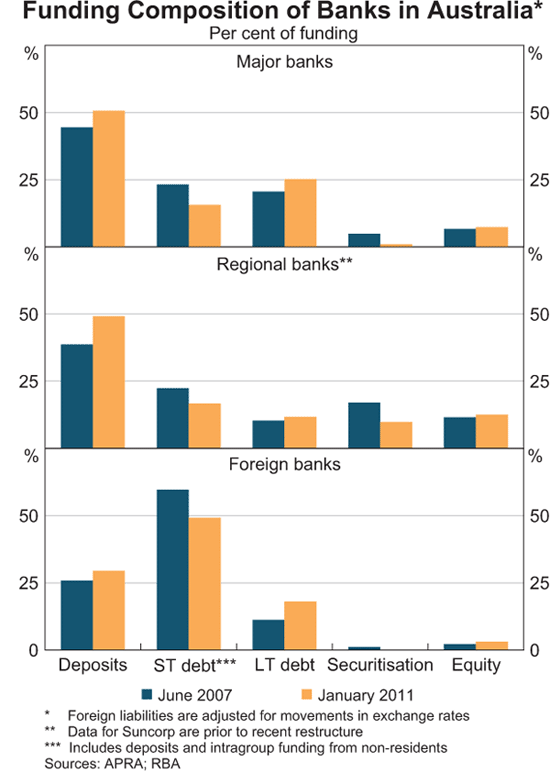
The increases in deposit and long-term debt funding have facilitated a decline in the share of funding sourced from short-term wholesale debt (domestic and foreign). The share of securitisation has also fallen since the onset of the financial crisis, as the amortisation of the outstanding stock of residential mortgage-backed securities (RMBS) has exceeded new issuance.
Furthermore, Australian banks have bolstered their balance sheets by raising equity, through a combination of retained earnings and share placements. This has led to an increase of nearly 1 percentage point, to 7½ per cent, in the share of equity in the major banks' funding liabilities since mid 2007.[2]
Cost of Debt Funding
Australian banks' cost of debt funding has increased materially over the past few years. This has reflected both increases in the costs of some of the components of debt funding as well as the shift towards more expensive sources of debt.
Deposits
Competition for deposits in Australia has intensified since around mid 2008, resulting in a significant increase in deposit rates relative to market benchmark rates. The average cost of the major banks' new deposits has risen noticeably relative to the cash rate; currently it is estimated to be only slightly below the cash rate, whereas prior to the onset of the financial crisis, it was about 150 basis points below the cash rate.
Within the deposit market, competition has been most pronounced for term deposits. The average spread above market rates of equivalent maturity on banks' term deposit ‘specials’ – the most relevant rate for term deposit pricing – has increased by around 150 basis points since the onset of the crisis (Graph 2). This average spread is currently a little below 100 basis points. For example, 6-month term deposit rates are currently around 6 per cent, compared to bank bill rates of about 5 per cent. Rates on at-call savings deposits – including bonus saver, cash management and online savings accounts – are currently estimated to be around 35 basis points below the cash rate compared with 100 basis points below in mid 2007. Overall, the average deposit cost for the regional banks is likely to have increased by slightly more than for the major banks, reflecting the regional banks' greater use of (relatively more expensive) term deposits.
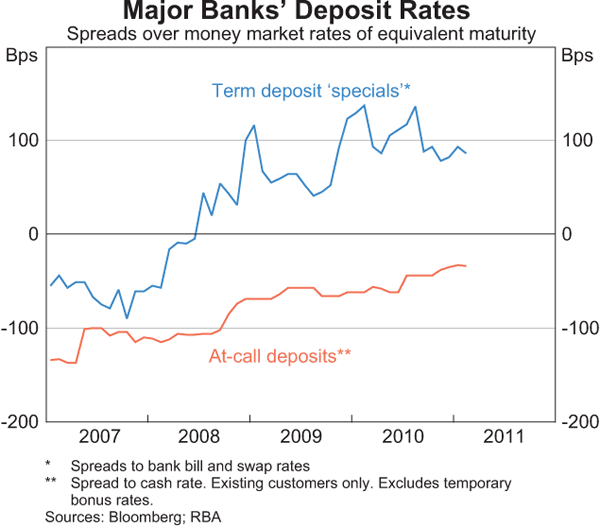
Wholesale debt
The cost of issuing long-term bonds increased significantly during the crisis.[3] For example, yields on 3-year bonds increased from around 50 basis points over Commonwealth Government Securities (CGS) in the years leading up to the crisis, to a peak in late 2008 of about 220 basis points for debt issued in Australia and at about 280 basis points for debt issued offshore (Graph 3). Improved capital market conditions have seen the cost of issuing new 3-year debt onshore fall to a little over 100 basis points recently. However, this decline in the cost has been offset to some extent as the major banks have lengthened the average maturity of their bond funding by issuing at longer tenors. Issuance over the past year has been at an average tenor of just over 4½ years, compared with 3 years in 2008.

Reflecting these developments, there has been a marked increase in long-term wholesale funding costs, with these costs estimated to have risen by about 110 basis points relative to the market's expectation of the cash rate. The cost of long-term wholesale debt continues to place upward pressure on banks' funding costs, as still nearly one-fifth of bonds outstanding were issued at lower spreads prior to mid 2008. As the repricing of maturing bonds continues, it is estimated that the average spread on banks' outstanding long-term debt will increase by about 15 basis points over the next year. If the share of long-term debt in overall funding were to remain at its current share of around 25 per cent, and spreads on new issuance remain steady, this would imply an increase in total funding costs from this source of just under 5 basis points over the next year.
The regional banks, which have lower credit ratings than the major banks, have experienced an even larger increase in the cost of long-term wholesale debt, though it is a smaller share of their total funding.
Short-term wholesale debt accounts for about one-fifth of banks' funding, and is priced mainly off 1-month and 3-month bank bill rates. Prior to mid 2007, bank bill rates closely tracked the market's expectation for the cash rate with the spread between 3-month bank bills and overnight indexed swaps (OIS) around 10 basis points. While the onset of the global financial crisis saw bank bill rates rise well above OIS rates, the sizeable risk premium has now largely dissipated. Hence, the major banks' short-term capital market debt is currently only about 10 basis points more costly relative to the expected cash rate than it was in mid 2007.
RMBS account for a negligible share of the major banks' funding, but are more important for the smaller financial institutions. The cost of new securitisation funding is roughly 100 basis points higher than before the onset of the global financial crisis. Given spreads on RMBS are similar for the different types of banks (and also for non-banks), securitisation has remained a relatively more cost effective funding source for the smaller banks.
Overall cost of debt funding
Since mid 2007, the higher cost of deposits has made the largest contribution to the overall increase in debt funding costs, reflecting their large weight in total funding and the 130 basis point rise in average deposit rates relative to the cash rate. Long-term wholesale debt has also made a substantial contribution to the increase in the major banks' debt funding costs. While the cost of short-term wholesale debt initially rose relative to the cash rate, it is now much closer to pre-crisis levels. In aggregate, it is estimated that the average cost of the major banks' debt funding is about 90 to 100 basis points higher relative to the cash rate, than it was in mid 2007 (Graph 4).
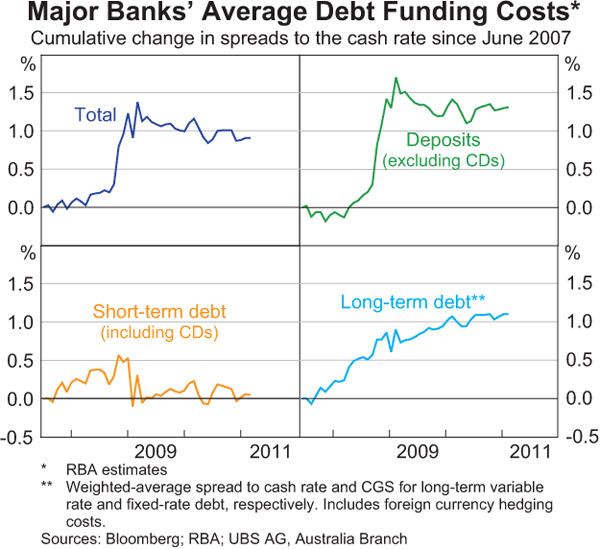
Most of the increase in the major banks' debt funding costs occurred during 2008 and early 2009, at the peak of the dislocation in markets. Since then the major banks' debt funding costs are estimated to have moved broadly in line with the cash rate, reflecting offsetting factors. The continued upward pressure on long-term funding, as bonds issued pre-crisis are rolled over at higher spreads, together with a small increase in the cost of term deposits, has been broadly offset by a decline in the spread to the cash rate on funding sources that have relatively fixed rates.
The available evidence suggests that the overall increase in the regional banks' debt funding costs since the onset of the financial crisis has been larger than that experienced by the major banks. This mainly reflects the larger rises in the costs of the regional banks' deposits and wholesale debt funding, and the large switch in their funding mix from securitisation to deposits, currently a relatively expensive source of funding.
Cost of Equity Capital
While equity is a non-interest bearing source of funds, banks aim to earn a return on this capital.[4] The cost of equity reflects the bank's total amount of equity funding and the return the bank seeks on this funding source. In our calculations the target return on equity is assumed to be constant at a historical average pre-tax rate of 20 per cent, and does not vary as the share of equity in funding changes. Furthermore, different types of loans will have different amounts of equity allocated to them determined by their riskiness. Given equity is a more expensive source of funds than debt, variation in the share of equity used to fund different types of loans will be one factor leading to different lending rates. For example, the higher level of risk associated with business lending than with residential mortgage lending means a greater share of equity capital needs to be set aside to fund these loans. As such, equity capital contributes more to the cost of funding business loans than residential mortgages (Graph 5).
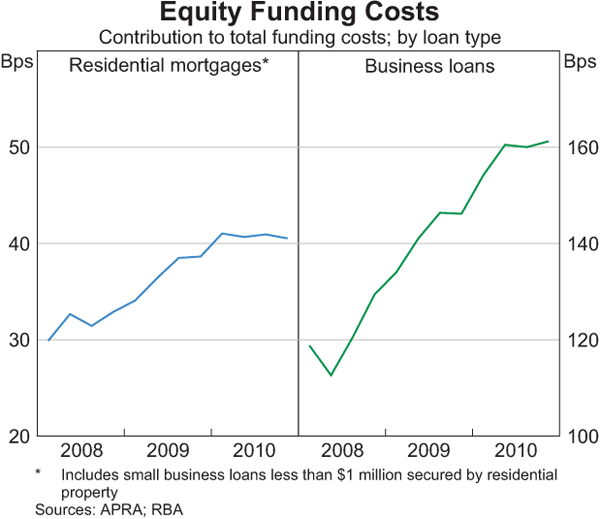
Based on our assumptions noted above, as well as the increase in credit risk (measured using the major banks' reported risk weights), there has been an increase in the contribution of equity to total funding costs, especially for business loans. For residential mortgage lending, it is estimated that about 2 per cent of the value of these loans is now funded from equity, up from around 1½ per cent in early 2008. This would have increased the equity cost of funding these loans by as much as 10 basis points, from around 30 basis points to just over 40 basis points.[5] In comparison, equity funding for business loans is estimated to have risen from about 6 per cent to 8 per cent of the value of these loans. As a result, this would have increased the equity cost of funding business loans by as much as 40 basis points, from around 120 basis points to 160 basis points.
Banks' Lending Rates and Pricing for Risk
In addition to the costs of debt and equity funding, lending rates include a risk margin designed to cover the expected losses from making that particular type of loan.
The following analysis focuses on two broad categories of lending for which it is possible to compare interest rates and credit risk (or expected loss) information under the current capital standards (referred to as Basel II).[6] The two categories are:
- residential mortgage lending (predominantly loans to households, but also includes residentially secured loans under $1 million to small businesses); and
- all other business lending.
Residential mortgage lending
In the decade prior to the crisis, indicator rates on banks' residential mortgage lending tended to move closely with the cash rate. This reflected that banks' debt funding costs also generally followed movements in the cash rate, in conjunction with little change in equity capital or expected losses. In addition, competitive pressures meant that it became commonplace for lenders to offer most household borrowers a discount, which gradually increased to around 60 to 70 basis points on the indicator rate (Graph 6).
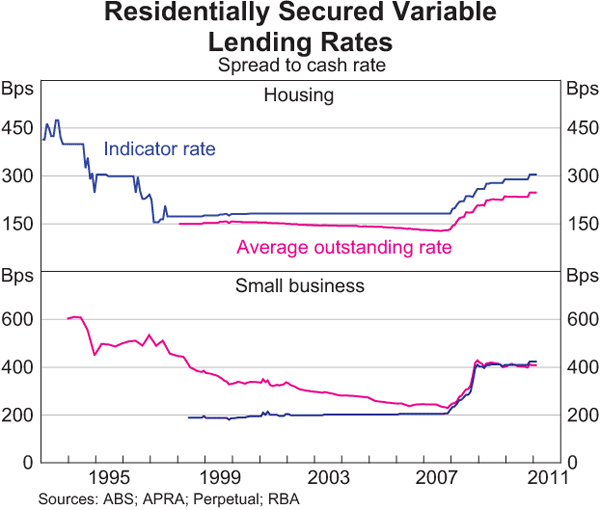
Banks also typically reduced risk margins on residentially secured lending to small businesses in the lead-up to the crisis. This reduction in risk margins, combined with an increase in the use of residential property as security (i.e. reduced unsecured lending), contributed to the overall reduction in average risk margins on the stock of small business lending.
Since mid 2007, the major banks' average interest rates on housing loans and residentially secured small business loans have each risen relative to the cash rate. Overall, it is estimated that the increase in the major banks' interest rates on residential mortgage lending, which is heavily weighted towards housing loans, has been about 120 basis points relative to the cash rate. Only a small part of this increase appears to reflect an increase in risk margins to account for higher expected losses, as the major banks reported that the expected loss rate for this type of lending rose by only about 5 basis points from March 2008 to a peak in March 2010. The major factor behind the increase in residential mortgage lending rates relative to the cash rate has been the increase in debt funding costs, with a modest contribution of about 10 basis points from the cost of equity funding.
Business lending
There can be considerable variation in interest rates across business loans, as banks base their pricing on the characteristics of the individual borrower and the quality of collateral (such as commercial property or equipment). The available evidence suggests that the average spread to the cash rate on new term loans to large businesses increased by about 200 basis points, from around 150 basis points in mid 2007 to a peak of around 350 basis points in mid 2009. Since then, spreads on new loans have declined, and are now closer to the average margin on existing loans. As such, the average margin on outstanding business lending facilities appears to have broadly stabilised (Graph 7). Overall, the average interest rate on outstanding business loans is estimated to have risen by about 120 basis points relative to the cash rate since mid 2007.
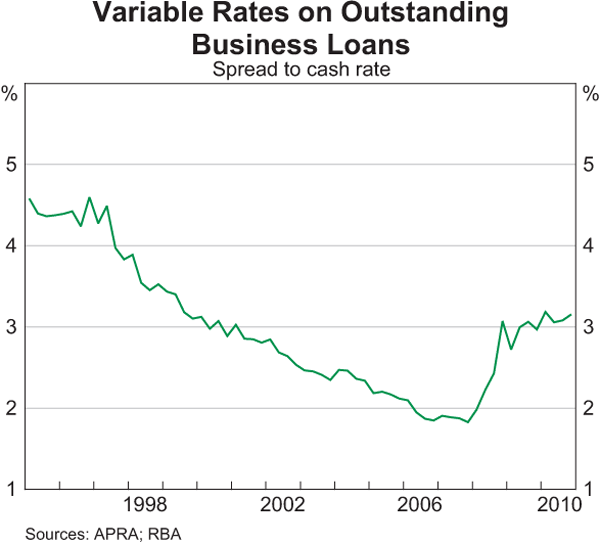
For business lending, debt funding costs have also been the largest individual driver of the increase in lending rates relative to the cash rate, though there have also been significant contributions from the cost of equity and from higher risk margins to cover expected losses. The expected loss rate reported by the major banks has increased from around 45 basis points to about 75 basis points. This has been mainly due to the banks' perceptions of a higher chance of default across borrowers, and implies an increase in risk margins of around 30 basis points. The significantly larger increase in the expected loss rate for business lending (relative to residential mortgage lending) appears broadly consistent with developments in actual loss rates experienced by the major banks.
Lending rates and net interest margins
Australian banks' net interest margins are largely driven by movements in interest rates on loans relative to debt funding costs. There is also an influence from other asset holdings, such as holdings of liquid assets, and other factors, such as net interest earnings from interest rate derivatives. An additional factor that influences the calculation of banks' margins is the amount of equity in funding, which is treated as having zero interest cost (i.e. non interest-bearing). However, as noted above, for the purposes of loan pricing, banks apply a cost to these funds.
While the net interest margins of the individual major banks differ, the average margin for these banks has fluctuated within a fairly narrow range between about 2¼ per cent and 2½ per cent over the past few years (Graph 8). After falling to historical lows in 2008 as funding costs rose early in the global financial crisis, the major banks' margins recovered a little, as lending rates increased by a little more than debt funding costs. Currently they are around the average level of the past five years. The above analysis broadly demonstrates that some of the increase in lending rates relative to debt funding costs can be explained by the banks passing on the higher costs of equity capital and the increase in expected losses. Consequently, some of the increase in the major banks' margins from their recent lows is also largely a reflection of these factors.
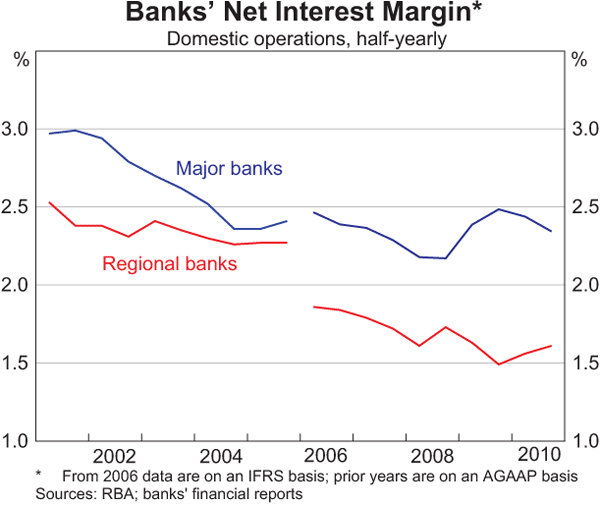
The regional banks' net interest margins lie below the major banks' margins, primarily reflecting more expensive deposit and long-term wholesale debt funding costs and a greater share of lower margin household lending. In contrast to the major banks, the regional banks' margins remain below their level in mid 2007. This reflects the regional banks' overall funding costs having risen by more than the major banks, and their overall lending rates having risen by a little less, reflecting differences in their lending mix.
Footnotes
The authors are from Domestic Markets Department. [*]
See Brown et al (2010) for details. [1]
For more details on banks' capital, see Gorajek and Turner (2010). [2]
See Brown et al (2010) and RBA (2010). [3]
While banks do not typically disclose the equity return targets that are used in their loan pricing decisions, the cost of equity is greater than that of debt. This reflects the greater risk borne by shareholders (who only have a residual claim on the income and assets of the bank). [4]
The equity cost of funding a loan is calculated by multiplying the share of equity used to fund the loan (e.g. currently 2 per cent for residential mortgages) by the target return on equity, which is assumed to be 20 per cent. [5]
The expected loss information reported by the major banks is based on the probability that borrowers will default, and the amount that the banks expect to lose in the event of default. [6]
References
Brown A, M Davies, D Fabbro and T Hanrick (2010), ‘Recent Developments in Banks' Funding Costs and Lending Rates’, RBA Bulletin, March, pp 35–44.
Gorajek A and G Turner (2010), ‘Australian Bank Capital and the Regulatory Framework’, RBA Bulletin, September, pp 43–50.
RBA (Reserve Bank of Australia) (2010), ‘Submission to the Inquiry into Competition within the Australian Banking Sector’, Submission to the Senate Economics References Committee Inquiry into Competition within the Australian Banking Sector, 30 November. Available at: <http://www.rba.gov.au/publications/submissions/inquiry-comp-aus-bank-sect-1110.pdf>.